 |
 |
 |
 |
 |
What was the first
thing you ever drew on a computer?
Probably a picture of the spaceship out of the comic strip
'Nemesis', on the ZX81, which I sent in to 2000AD magazine.
They printed it and I got five pounds!
And
the first thing you did for a game?
The titlescreen (and Amstrad graphics) for Ghosts'n Goblins.
Strangely John did a graphic adventure a year or so before
called Ghost Town which he sold to Virgin, and I didn't
do any graphics for that at all. I can't remember why.
He probably thought he could draw better than me!
The best one?
The best game is probably Wetrix, although there aren't
that many graphics in it. I don't really have a favourite
set of graphics for a game, there's something wrong with
all of them. I was very pleased with the way Ken Griffey
turned out. We did a really professional job which was
technically very good - and on time.
The
worst one?
The Amiga version of World Darts was embarrassing because
it had some of the most atrocious graphics in it I'd ever
seen. They weren't done by me, but I didn't want my name
on it all the same. Same with Spiderman and X-men; a disaster
of a game which I only helped out on at the end, but not
one to be proud of.
The
hardest one?
Converting all the graphics for Maximum Carnage from the
SNES to the Genesis, virtually on my own in a few weeks,
without knowing how they worked, and whilst fixing all
the problems with the SNES graphics because the lead artist
had done a runner.
The best arcade conversion?
I worked on a conversion of a virtually unknown coin-op
called Motos, which was a great little game. Plok on the
SNES was based on a game called Fleapit which we wrote
on Rare's RAZZ arcade hardware.
The
one that drove you completely insane?
Probably Spiral Saga which we were doing as a follow up
to Equinox on the Playstation, because it was taking forever.
Its since been cancelled.
The
one done in shortest time?
All the old Spectrum and C64 games were done in a really
short time by today's standards, but at the time we were
always late so they don't count. I guess Wetrix has been
developed at the quickest pace.
The
one that took the longest to paint?
Equinox. It wasn't that it took that long, the game took
about 1 and 1/2 years, but there was only John and myself
on it for most of that time. The game took forever to
get approved by Nintendo, and we had to keep making unnecessary
changes. They finally let us bring the game out with a
virtually identical version to the one we originally submitted!
But Equinox was the first SNES
game you did and the first SNES game to be done outside
Japan. Atleast that must have been exciting.
Definately. That's why we both moved to Software Creations,
to work on the only SNES development kit available, but
I think that put a few noses out of joint at Creations
as there were some people who'd been there for years and
resented John and I coming in and getting the plum job.
How did the working progress
look like from idea to finished product?
Its hard to describe, except to say that you do
need imagination to see the finished game in your head,
as what you see on the screen mid project is not always
encouraging. Inexperienced managers often think that projects
are going disastrously wrong because they still look broken
until very close to completion, but that's the way development
works.
Did you ever ran
out of ideas?
We've never run out of ideas, we just run out of time
to develop them.
Let's talk a bit more in-depth about
the C64 games you've worked on, starting from the top
with 180.
I had a real soft spot for this game. It was the first
thing I worked on when I started my job at Binary Design,
and of course the hand is copied off my own hand. It was
hard to do because I needed two hands to work the (keyboard)
controls of the sprite editor I was using, so I had to
keep lifting up my right hand and doing the dart throw
motion, then quickly try to plot the right pixels using
both hands while I held that image in my mind.
Amaurote
This one was a bit of a bodge. My brother originally designed
Amaurote on the Spectrum, and it was based around an isometric
3D landscape system, and pretty much designed for the
Spectrum full stop. At that time, virtually every game
we did was for Spectrum/Amstrad/C64, so we had to come
up with an adaptation of the game for the C64, which wasn't
really satisfactory. At the time I was only really used
to monochrome graphics. Most of the drawing I did in my
spare time was black and white line art, and most of the
computer work I had done was monochrome, so I didn't have
much clue about colour, hehe, and I seem to remember Amaurote
being a little ugly. I was quite proud of the font I designed
for the game, although looking back its almost unreadable!
What were the difficulties
and advantages in drawing graphics on the Speccy compared
to the C64?
I hated working on the C64 - the pixels weren't square,
the colours were random and washed out, the graphics tools
were always terrible and the video output was awful, so
I was always squinting at the screen to see what I was
doing. I always worked on the C64 quite reluctently, probably
explaining why I never did anything good on it. The Spectrum
was better because I had a great sprite editor (written
by my brother) and a great screen editor (Melbourne Draw),
even though storage was a pain. The Amstrad was good to
work on because it was the only machine with a decent
monitor - not a TV.
What about
Death Wake then?
I did nothing on this game except provide an 8x8 pixel
font, as I was quite good at making readable fonts (which
was a rare skill, believe it or not). This was my brother
John's first project at Binary Design. I think he had
eight weeks in which to design and write the game from
scratch.
Defcom
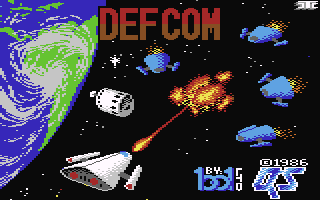 I
have no good memories of this project. The 'concept' such
as it was came down from above, from the publisher. Probably
Ron Harris if my memory serves correctly: "We want
a game called Defcom!!". So, nobody on the team actually
wanted to make this game, or had any love of the idea
or anything, and there wasn't really an idea as such.
In those days (or at that company) there wasn't a position
of 'game designer'. The project (in this case just a title)
was given to the team to write, with a deadline. From
a management point of view I don't think that there was
any recognition that there was a development stage missing;
that a game had to be designed, that the title itself
didn't explain to the team exactly what the content of
the game they were producing was. So, the programmers
just started working out ways for spaceships to fly over
a rotating earth, as that was the 'idea' of the game.
I recall that the guy writing the C64 version wasn't the
best programmer around, and used whatever the simplest
technique was which got the quickest results, regardless
of the implications for the rest of the project. Ultimately
I suppose this was a rewarding project, as this was a
valuable lesson in "how not to make a video game". I
have no good memories of this project. The 'concept' such
as it was came down from above, from the publisher. Probably
Ron Harris if my memory serves correctly: "We want
a game called Defcom!!". So, nobody on the team actually
wanted to make this game, or had any love of the idea
or anything, and there wasn't really an idea as such.
In those days (or at that company) there wasn't a position
of 'game designer'. The project (in this case just a title)
was given to the team to write, with a deadline. From
a management point of view I don't think that there was
any recognition that there was a development stage missing;
that a game had to be designed, that the title itself
didn't explain to the team exactly what the content of
the game they were producing was. So, the programmers
just started working out ways for spaceships to fly over
a rotating earth, as that was the 'idea' of the game.
I recall that the guy writing the C64 version wasn't the
best programmer around, and used whatever the simplest
technique was which got the quickest results, regardless
of the implications for the rest of the project. Ultimately
I suppose this was a rewarding project, as this was a
valuable lesson in "how not to make a video game".
Feud
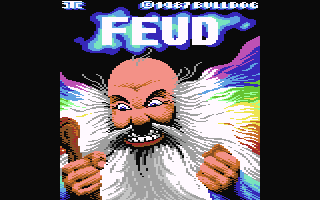 Feud
was another game designed by my brother. In the light
of projects like Defcom, John was pushing for the concept
of 'game design' to be recognised at Binary Design. It
was a real struggle to get across the idea that somebody
should design a game before we start to write it, that
the design itself was quite important to the quality of
the finished product, and that the design was worth paying
for. Anyway, he got the Feud design accepted, and he wrote
the Spectrum version, which was quite good. The idea was
that you were a wizard, having a 'death match' with another
wizard. You both competed for resources (the spell ingredients)
needed to fight each other. It was a simple concept, but
centrally important were the two ideas that the map was
real (i.e. each screen joined properly with the next,
and you could learn shortcuts etc.) and the game kept
track of items on the map (if you picked up a certain
herb, it was unavailable to the other wizard for a while,
and vice versa), and that the other wizard had proper
AI to navigate around the map so you could really race
him or he could beat you, and you could chase each other. Feud
was another game designed by my brother. In the light
of projects like Defcom, John was pushing for the concept
of 'game design' to be recognised at Binary Design. It
was a real struggle to get across the idea that somebody
should design a game before we start to write it, that
the design itself was quite important to the quality of
the finished product, and that the design was worth paying
for. Anyway, he got the Feud design accepted, and he wrote
the Spectrum version, which was quite good. The idea was
that you were a wizard, having a 'death match' with another
wizard. You both competed for resources (the spell ingredients)
needed to fight each other. It was a simple concept, but
centrally important were the two ideas that the map was
real (i.e. each screen joined properly with the next,
and you could learn shortcuts etc.) and the game kept
track of items on the map (if you picked up a certain
herb, it was unavailable to the other wizard for a while,
and vice versa), and that the other wizard had proper
AI to navigate around the map so you could really race
him or he could beat you, and you could chase each other.
The C64 programmer was the same guy who worked on Defcom.
Instead of using my map (which all joined up properly)
he just created a list of 'screens', and plonked objects
like trees, bushes, huts etc. here and there on each screen.
He then just decided randomly whether or not the enemy
wizard should appear at the edge of the screen you were
on. So the wizard could walk off the bottom of the screen,
then instantly walk back on the top. There was no map
as such to keep track of the enemy wizard on, and no code
to even attempt to keep track of your enemy. More valuable
lessons: even with a good game design, it was still possible
to make a game completely the wrong way.
Did the bosses care about crap ports
at all and did you at any time point out to the bosses
that someone wasn't skilled enough to do his job?
Erm, well John and I were never scared of speaking our
minds, so we probably did mention it, but it wasn't our
company, and we were both only young. The owner of the
company was, understandably, primarily concerned with
meeting deadlines and getting paid rather than with the
artistic merits of each game.
Ghosts'n
Goblins
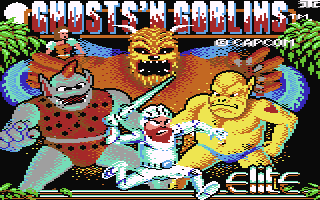 It was actually the Amstrad titlescreen that I did. Before
that I'd done tons of titlescreens like that for myself
of existing games or game adverts, which nobody ever saw.
I was just a computer geek. I did all the graphics for
the Amstrad version and the titlescreen was converted
to the C64 by Mike Webb who wrote his own converter program.
I had nothing to do with it really.
It was actually the Amstrad titlescreen that I did. Before
that I'd done tons of titlescreens like that for myself
of existing games or game adverts, which nobody ever saw.
I was just a computer geek. I did all the graphics for
the Amstrad version and the titlescreen was converted
to the C64 by Mike Webb who wrote his own converter program.
I had nothing to do with it really.
Shite,
maan! One of my favourite pics wasn't draw on the C64!
A lot of people are surprised by this. Like I said, I
was never a C64 kid. I hated the blurred, washed out colours,
and the fact that all the graphics editors required a
joystick. It just goes to prove that the Z80 machines
were better!
You really don't like the C64,
do you?! Was there anything good about it?
The only good thing about the C64 was that it could move
sprites around fast so you could have more 50/60Hz games.
And that's it?
Yes!
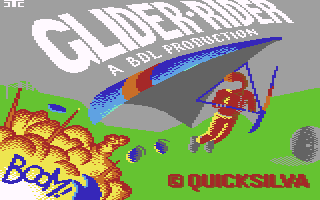
Did you do any in-game graphics
for Glider Rider or just the titlescreen?
As with Death Wake, I did nothing on this other than the
font and the titlescreen.
Hyperbowl
My mind is completely blank!
How come you worked on Knight Games
2? I mean, it was not a Binary release.
This was something I did for Phil Morris of English Software
(or Phil English as we called him), whose offices were
right behind Binary Design's. Quite a few of us from Binary
used to nip down there at lunch time some days and get
'foreigners' from him, short little freelance jobs that
we would do in the evenings or weekends. I never met the
programmer or had anything much to do with the game, I
was just given some backgrounds to do. As with Amaurote,
I wasn't really very good at C64 colour graphics, so this
isn't really anything I have any great affection for.
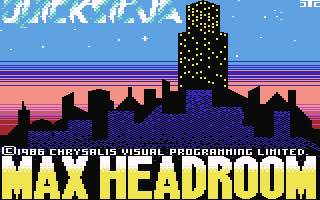 Max
Headroom Max
Headroom
Same as Glider Rider and Death Wake.
Motos
This was a neat little coin-op we did a conversion of.
No other memories...
Scooby
Doo
Another foreigner I did for Mike Webb, who was previously
one of the founders of Binary Design, and who went on
to be one of the owners of Software Creations (my future
employers), but who at the time was working freelance.
I was in Binary Design working one Saturday (for free!)
and he popped in and asked me to do some conversion work
on some sprites from the Spectrum version, which I did.
Nothing much really.
Zub
Another game like Feud and Amaurote designed by my brother,
with the Spectrum in mind really. It was a game that we
never properly finished as it needed some more gameplay
features (pickups etc.) to round it out, but we didn't
have time. I remember that the C64 version wasn't really
satisfactory.
Who is your
favourite programmer, artist and musician from the old
days?
The guy who wrote Tau Ceti on the Spectrum, and the guy
who wrote the Hewson games on the Spectrum. Artist would
have to be Tim Stamper from Ultimate (Rare). Those first
Spectrum games blew my mind and really inspired me. Musician?
It would have to be Dave Whittaker. Not for the music
(sorry Dave), but just because I liked him.
Were you ever involved in the
demo scene?
I wasn't really involved in the demo scene. That was a
C64 thing and I was always a Spectrum kid. We didn't have
modems or anything on the Spectrum. Any demos with my
name on were done by my friend HAL (who now works for
EA writing FIFA games), a C64 programmer I met at Binary
Design.
What is the most giving thing you've
got through your computer interest?
Hmm, not sure exactly what you mean here... I've made
some great friendships over the years with the people
I've worked with, but I'm not sure that's to do with computers
particularly, although this industry does attract some
real 'characters' and interesting people. As I've gotten
older, I think that the fond memories people have of the
older 8-bit games I've worked on is very nice to hear
about. Its heart warming to think that you've provided
such great memories for other people.
Do you still have the old 8-bit
systems lying around?
I wanted to keep them, but I never did. You don't really
need them thanks to emulators. We have an old NES, including
one with a disk drive built in, a PC Engine and an old
MSX lying around at work.
How about doing something on the
8-bit machines again, just for fun?
Hell no! Making games is fun, but hard work and time consuming.
I wouldn't go through the effort required to make a game
unless I thought it was for a platform that people were
actually using!
Despite hating the C64, do you have any final words for
all of us who actually liked the stuff you did on this
machine?
You were all wrong - the Spectrum was better!
»
Go back
to the first part of the interview
|
|
 |
 |
 |
 |
|
 |
|
 |
|